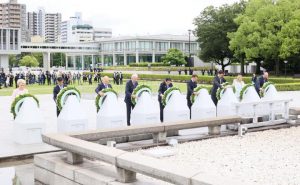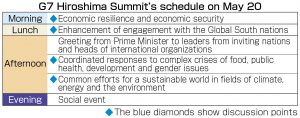G7 leaders lay flowers at Cenotaph for A-bomb Victims at opening of G7 Hiroshima Summit: Hiroshima Vision on nuclear disarmament is issued
May 20, 2023
by Koji Higuchi, Staff Writer
On May 19, the summit meeting of G7 (Group of Seven industrialized nations) started in Hiroshima. Leaders from participating nations, including the nuclear-armed U.S., U.K, and France, as well as the non-enumerated European Union (EU), toured the Peace Memorial Museum at Peace Memorial Park in Naka Ward, and had dialogue with an A-bomb survivor. The leaders then offered a wreath of flowers in front of the Cenotaph for the A-bomb Victims and mourned for A-bomb victims, bringing an historic day to Hiroshima, the A-bombed city. After the first-day discussion was finished, they released the “G7 Leaders’ Hiroshima Vision on Nuclear Disarmament” and stressed the importance of the record of non-use of nuclear weapons.
Among the G7 nuclear nations, U.K. Prime Minister Rishi Sunak and French President Emmanuel Macron visited Hiroshima for the first time as the incumbent leaders of both nations. President Joe Biden from the United States, the other nuclear power in the G7 which also dropped the atomic bomb, is the second sitting U.S. President visiting Hiroshima, following a visit by Barack Obama, then U.S. president, in 2016.
In the morning, the leaders arrived at Peace Memorial Park by car one after the other. Under the main building of the Peace Memorial Museum, they were greeted by Prime Minister Fumio Kishida and his wife Yuko. Then they entered the museum and stayed for about 40 to 90 minutes. According to the Japanese government, they viewed belongings left by A-bomb victims and met with Keiko Ogura, 85, an A-bomb survivor who experienced the atomic bombing in Ushita-machi (now part of Higashi Ward) when she was eight. Also, Hiroshima Prefectural Governor Hidehiko Yuzaki shared with the leaders at the museum the story of Sadako Sasaki, a girl who died of the A-bomb-induced leukemia at age of 12, ten years after she had experienced the atomic bombing.
After they left the museum, the G7 leaders walked to the Cenotaph for A-bomb Victims and offered a flower wreath one by one at the Cenotaph. They took a far look at the A-bomb Dome near from the cenotaph and listened to its history from Hiroshima Mayor Kazumi Matsui. They planted a seedling from an A-bombed cherry tree at a corner of the park, too.
The G7 Leaders’ Hiroshima Vision renounces nuclear war, by announcing that any use of nuclear weapons by Russia is inadmissible. The plan also advocates for the continuation of the overall decline in global nuclear arsenals, and demonstrated a commitment to the ultimate goal of a world without nuclear weapons with undiminished security through a realistic and pragmatic approach.
As for the G7’s security policies, the vision stressed, “Our security policies are based on the understanding that nuclear weapons, for as long as they exist, should serve defensive purposes, deter aggression and prevent war and coercion.” Nuclear deterrence was virtually affirmed.
Other attending G7 leaders are: Italian Prime Minister Giorgia Meloni, Canadian Prime Minister Justin Trudeau, German Chancellor Olaf Scholz, European Council President Charles Michel, and European Commission President Ursula von der Leyen. They debated topics such as the world economy and the Ukraine situation at the Grand Prince Hotel Hiroshima in Minami Ward, the summit’s main venue. In the evening, they went to Miyajima Island in Hatsukaichi, Hiroshima Prefecture and paid a visit to Itsukushima Shrine. Nuclear disarmament and non-proliferation topics were then discussed over dinner.
(Originally published on May 20, 2023)
On May 19, the summit meeting of G7 (Group of Seven industrialized nations) started in Hiroshima. Leaders from participating nations, including the nuclear-armed U.S., U.K, and France, as well as the non-enumerated European Union (EU), toured the Peace Memorial Museum at Peace Memorial Park in Naka Ward, and had dialogue with an A-bomb survivor. The leaders then offered a wreath of flowers in front of the Cenotaph for the A-bomb Victims and mourned for A-bomb victims, bringing an historic day to Hiroshima, the A-bombed city. After the first-day discussion was finished, they released the “G7 Leaders’ Hiroshima Vision on Nuclear Disarmament” and stressed the importance of the record of non-use of nuclear weapons.
Among the G7 nuclear nations, U.K. Prime Minister Rishi Sunak and French President Emmanuel Macron visited Hiroshima for the first time as the incumbent leaders of both nations. President Joe Biden from the United States, the other nuclear power in the G7 which also dropped the atomic bomb, is the second sitting U.S. President visiting Hiroshima, following a visit by Barack Obama, then U.S. president, in 2016.
In the morning, the leaders arrived at Peace Memorial Park by car one after the other. Under the main building of the Peace Memorial Museum, they were greeted by Prime Minister Fumio Kishida and his wife Yuko. Then they entered the museum and stayed for about 40 to 90 minutes. According to the Japanese government, they viewed belongings left by A-bomb victims and met with Keiko Ogura, 85, an A-bomb survivor who experienced the atomic bombing in Ushita-machi (now part of Higashi Ward) when she was eight. Also, Hiroshima Prefectural Governor Hidehiko Yuzaki shared with the leaders at the museum the story of Sadako Sasaki, a girl who died of the A-bomb-induced leukemia at age of 12, ten years after she had experienced the atomic bombing.
After they left the museum, the G7 leaders walked to the Cenotaph for A-bomb Victims and offered a flower wreath one by one at the Cenotaph. They took a far look at the A-bomb Dome near from the cenotaph and listened to its history from Hiroshima Mayor Kazumi Matsui. They planted a seedling from an A-bombed cherry tree at a corner of the park, too.
The G7 Leaders’ Hiroshima Vision renounces nuclear war, by announcing that any use of nuclear weapons by Russia is inadmissible. The plan also advocates for the continuation of the overall decline in global nuclear arsenals, and demonstrated a commitment to the ultimate goal of a world without nuclear weapons with undiminished security through a realistic and pragmatic approach.
As for the G7’s security policies, the vision stressed, “Our security policies are based on the understanding that nuclear weapons, for as long as they exist, should serve defensive purposes, deter aggression and prevent war and coercion.” Nuclear deterrence was virtually affirmed.
Other attending G7 leaders are: Italian Prime Minister Giorgia Meloni, Canadian Prime Minister Justin Trudeau, German Chancellor Olaf Scholz, European Council President Charles Michel, and European Commission President Ursula von der Leyen. They debated topics such as the world economy and the Ukraine situation at the Grand Prince Hotel Hiroshima in Minami Ward, the summit’s main venue. In the evening, they went to Miyajima Island in Hatsukaichi, Hiroshima Prefecture and paid a visit to Itsukushima Shrine. Nuclear disarmament and non-proliferation topics were then discussed over dinner.
(Originally published on May 20, 2023)








